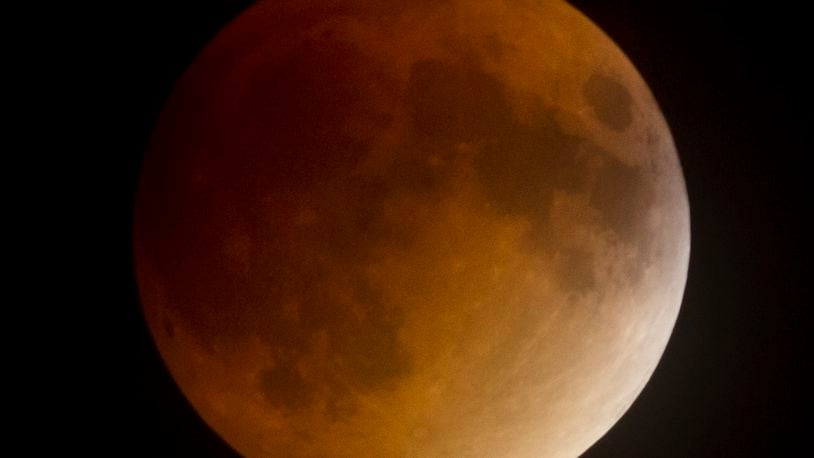1. January 31: Super blue moon eclipse/blood moon
For the second time in January, there will be a full moon, and when that occurs within the same calendar month it is referred to as a “blue moon.”
It will also be the third in a series of three straight full moon supermoons – that is, super close full moons. But this time, the full moon will pass through the Earth’s shadow during the early morning of Jan. 31 to give us a total lunar eclipse and the first blue moon total eclipse in America in 150 years.
During the time of the total eclipse, the moon will appear reddish in color, which is where it gets to be called a “blood moon.” The eclipse will get underway in Ohio around 6:48 a.m., and totality (when the moon will be entirely inside the Earth’s dark shadow) will last a bit more than an hour and 15 minutes.
» READ MORE: Another eclipse is on the way, featuring a ‘blood moon’
2. February 15, March 17, April 16, May 15, June 13: New moon
On these dates, there will be a new moon located on the same side of the Earth as the sun, and it will not be visible in the night sky. It is the best time of the month to observe faint objects, such as galaxies and star clusters, because there is no moonlight to interfere.
3. March 15: Mercury at best evening viewpoint
When an inferior planet is visible after sunset, it is near its greatest eastern elongation, and Mercury reaches this point at 18.4 degrees from the Sun on March 15. This is the best time to view Mercury since it will be at its highest point above the horizon in the evening sky. Look for the planet low in the western sky just after sunset.
4. April 22-23: Lyrids Meteor Shower
The Lyrids Meteor Shower runs annually from April 16-25, but it peaks this year on the night of the 22nd and morning of the 23rd. These meteors, caused by dust particles left behind by comet C/1861 G1 Thatcher, can sometimes produce bright dust trails that last for several seconds.
The first quarter moon will set shortly after midnight, leaving dark skies for what could be a good show. Best viewing will be from a dark location after midnight.
Meteors will radiate from the constellation Lyra, but can appear anywhere in the sky. It produces about 20 meteors per hour at its peak.
» MORE TRENDING NEWS: The Great Blizzard of 1978: Why we can’t forget it
5. May 6-7: Eta Aquarids
The Eta Aquarids runs annually from April 19 to May 28, but it peaks this year on the night of May 6 and the morning of the May 7. The waning gibbous moon will block most of the fainter meteors this year, but you should be able to catch quite a few good ones if you are patient.
Best viewing will be from a dark location after midnight. Meteors will radiate from the constellation Aquarius, but can appear anywhere in the sky. The Eta Aquarids is produced by dust particles left behind by comet Halley and is capable of spawning 30 meteors per hour at its peak.
6. May 9: Jupiter at Opposition
The giant planet will be at its closest approach to Earth on May 9, and its face will be fully illuminated by the Sun. It will be brighter than any other time of the year and will be visible all night long, so this is the best time to view and photograph Jupiter and its moons. A medium-sized telescope should be able to show you some of the details in Jupiter's cloud bands, and a good pair of binoculars should allow you to see Jupiter's four largest moons, appearing as bright dots on either side of the planet.
7. June 27: Saturn at Opposition
The ringed planet will be fully illuminated by the sun on June 27, as it makes its closest approach to Earth. Just like Jupiter is brightest on May 9, Saturn will be brighter than any other time of the year at this time and will be visible all night long – thus making this the best time to view and photograph Saturn and its moons. A medium-sized or larger telescope will allow you to see Saturn's rings and a few of its brightest moons.
About the Author
